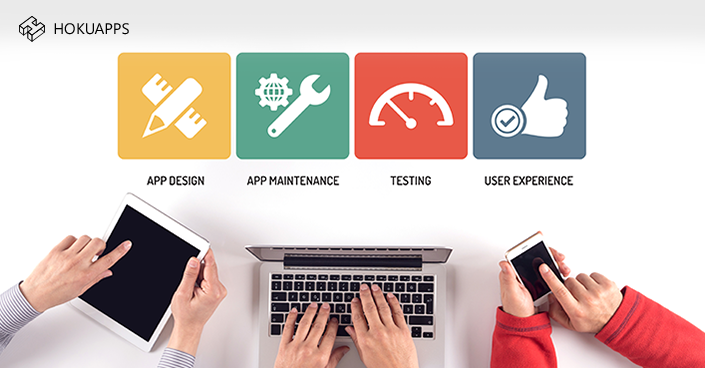- Products
- Solutions
- Services
- Resources
- Customer Success
- Company
- Sign In
- Contact Us

Digital Transformation enabler helping enterprises evolve by connecting technology
Take a look at upcoming webinars and special events
HokuApps news and media coverage
Be with the best. Solve real problems
Get in touch with our experts here
Explore our extensive collection of online resources here
Information and insight on transformation to the Digital Workplace
Quick Guides provide concise information on a variety of topics
Discover the essence of HokuApps’ products
Learn all about HokuApps’ cutting-edge enterprise mobility technology

When it comes to software application development, what do you favor going for new innovative application development processes, or taking watchful steps by following an in-house strategy?
If you think that the second alternative means safe business growth, you are quite mistaken. A vast majority of organizations are still falling prey to the loopholes present in traditional app development processes. And the outcome can be more devastating than you can imagine, both financially and strategically.
As you seek to completely digitize your business operations, you need to provide your employees with advanced tools and applications that provide the right context for the tasks at hand and help them execute the same with greater efficiency. For example, if your employees do not have instant access to the order history of a particular customer, customer service will inevitably suffer. The good news is that almost all companies eyeing digital business transformation understand the importance of building the right kind of enterprise-level apps.
However, quite surprisingly, most of them end up learning from what other companies are doing and play safe. This causes operational disruptions in the long-run. This is one of the major reasons that although contemporary alternatives like Rapid Application Development Platform have been around for quite some time, as many as 88% of companies still struggle with their buy vs. build mentality.
Still confused? Let us tell you the other side of the story.

The demand for business-specific apps is ever-increasing. On the contrary app developers’ ability to deliver is not able to match up to demand. Recent research reveals that almost 71% of IT feel that they are unable to keep up with the increasing pace of enterprise needs.
On the other hand, your enterprise functions through various systems, such as Enterprise Resource Planning (ERP), CRM, account payable invoicing and a lot more. If you choose to use a single app for each of the systems, it is very likely that your employees will reject them due to the increasing challenges faced and lack of familiarity with each system.
The following statistics from Forrester Research is even more alarming, showcasing why the majority of organizations need to rework their enterprise application strategies:
• Almost 47% of the IT personnel believe that outdated information and inefficient information management can significantly impact employee productivity.
• 48% of IT continues to struggle in developing content-rich apps and integrate both structured and unstructured data in the app to connect the disparate systems.
• Per revelations IT experts, building apps from scratch or, buying the same without appropriate IT guidelines can lead to frequent change requests and shadow IT by up to 48%.
Undoubtedly, this ever-changing business dynamics leads us to our current scenario, i.e., to the RAD platform becoming an absolute necessity for organizations. Enterprise RAD model came as a revolutionary response to the traditional waterfall model, which is clearly a misfit in the quick-paced software development world. One of the significant benefits of RAD platform is that you do not need to address all app components at the same time.
The enterprise RAD model is incremental and iterative, on which you can develop multiple app functions simultaneously as some separate mini projects. These individual developments are time boxed and assembled into a functional app prototype later. RAD platform thus allows more flexibility to the app developer, who can constantly modify the prototype in a dynamic environment per the feedback received in the app lifecycle.
The Enterprise RAD model allows app developers prioritize speed and agility, which, in turn, boosts productivity and enables them to concentrate on multiple app development projects, at the same time. Unlike the turnaround time of months or years, which is quite common with traditional app development models, RAD platform allows developers to deliver apps within an unbelievably short duration.
Apart from enhancing development speed, there are other benefits of RAD platform which can give your business that much-needed competitive edge. Here is a look at it:
With the enterprise RAD model, app developers can process the change requests quickly and deliver a production-ready app. This expedites the process from a very early stage – meaning, you do not necessarily need to wait for the incorporation of all functionalities to launch the app on RAD platform. Changes can be frequently incorporated into simple updates while the app is still in the market.
Whether you are building the app for your employees or customers, enterprise RAD model equips you with point-and-click functionality. This is essentially through low coding – a feature that makes RAD stand out in a very crowded marketplace. With this feature, your app developers can easily make modification per customer response and expand the solution till it becomes a perfect fit.
Is your organization having to deal with a number of the disconnected systems? Well, in that case, the RAD platform is perhaps just what you have been looking for. It offers a uniform low-code development platform on which your functional departments and app developers work together. This aspect of RAD platform fills the gaps in app development process. As a result, you create fully functional and business-specific apps that seamlessly integrate with your existing systems. All modules can be easily integrated into RAD platform, mitigating the chances of having bugs in the app. Once users are exposed to the various functionalities, you can make as many changes as you want without providing any extra effort/training.
RAD platform helps you configure applications on one central platform acting as an integration hub. This is the place where all structured and unstructured corporate data can be connected with the app content. Thus, the RAD platform united information silos.
For the appropriate utilization of enterprise RAD model, you need to keep your strategic framework for app development business-specific and open to changes. We have often seen that lack of appropriate planning and right understanding of business needs lead to unhappy and confused clients.
Also, the process itself goes through unnecessary complications and delay. We strongly advise that you consider the following prior to selecting a RAD platform for developing your enterprise apps:
• Your app development project is large enough to be split into different modules. If system modules are fixed, RAD model is not a very suitable option for app development.
• You can easily collect the user responses to make the changes frequently. This is the whole idea of RAD platform. If users are not kept in the loop, the develop app might lack many functionalities.
• You need the app to be delivered within a very specific time-frame. If it is a long-term project, you should consider other alternatives like investing in an in-house team.
• There are no other technical risks involved with the project.

HokuApps Rapid Application Development Platform helps you create high-quality enterprise-level apps at 10X speed over traditional programming methods. Our speed of app delivery comes with the low-code enterprise RAD model that provides highly customizable apps with easy upgrade and maintenance. To know more, here’s a blog on enterprise RAD success factors. Our app developers will accompany you from the initial app development stage to deployment, delivering business-specific apps that can accommodate any complex workflows. Keep pace with digital innovation with HokuApps RAD platform, and configure next-generation apps within minutes.
Have you tried the RAD platform yet? Let us know your thoughts/suggestions in the comment box below!